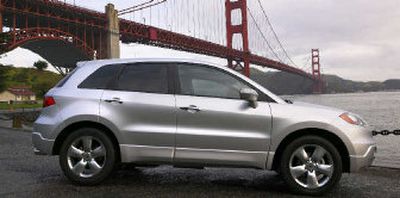Don Adair : Acura RDX covers all sweet spots

Let’s say — just for the sake of hypotheticals — that you’re a car company named Acura and you’re lacking a vehicle in a key segment.
It’s a relatively new category and one expected to undergo explosive growth. They call it the entry-level, premium crossover-utility-vehicle category, which translates to small, sporty crossovers.
The category is important to Acura because: a) it is expected to grow by more than 500 percent in the next five years; and, b) any category that puts a premium on luxury and sport is Acura’s turf.
Many companies in this situation would build a new rig on an existing platform. They’d spruce up the suspension and the sheet metal, add leather, wood and a nav system, and — presto, change-o — good to go.
Acura had access to a serviceable compact SUV platform in the form of the Honda CR-V. Instead, it built an all-new platform, one that shares DNA with its siblings and not much more.
The new, all-wheel-drive RDX crossover targets young, urban males and takes BMW’s X3 square in its crosshairs. It’s handsome, quick and luxurious. It offers sport-sedan handling, more technology than a Silicon Valley start-up and, with the rear seats folded, a cargo hold large enough for two 19-inch mountain bikes.
At $33,665 for starters, it doesn’t come cheap, but you don’t unseat BMW by cutting corners.
A turbocharged 2.3-liter four provides the pulse. It makes 240 horsepower and 260 foot-pounds of torque — more than any other Acura (and let’s not forget it’s torque that creates acceleration) — and more than the X3.
Nominally a five-passenger vehicle, the RDX comfortably accommodates four, although “comfort” is an understatement; the RDX is comfortable like a Ferrari is fast.
Uplevel materials flood the quiet and elegant cabin: the creamy tactile quality of the switchgear is the automotive equivalent of fine chocolate; the seats support and embrace; and interior surfaces please the eye and the touch. Even the plastics have a quality cast.
Gauges glow in a cool, blue hue and a storage bin in the center console will swallow a notebook computer.
In Acura fashion, the RDX comes loaded. Standard gear includes 18-inch alloy wheels, xenon headlights, moonroof, heated front seats and mirrors, eight-way power driver’s seat, leather upholstery, dual-zone automatic climate control and a full complement of power accessories.
The 360-watt audio system boasts seven speakers; an MP3-capable, six-disc CD changer; satellite radio, and satellite steering-wheel controls.
An optional Technology Package adds an eight-channel, 410-watt, surround-sound audio system that plays DVD-Audio discs. You may never again go inside the house to listen to music.
In addition to a full set of airbags, safety gear includes antilock brakes with brake assist, stability control, traction control and a rollover sensor for the curtain bags. The RDX also employs Honda/Acura’s new Advanced Compatibility Engineering (ACE), which in a crash directs the energy of an impact away from the passenger cabin.
Down where the rubber meets the road, Acura’s Super-Handling All-wheel Drive system maximizes traction by distributing torque front-to-rear and side-to-side along the rear transaxle.
During hard cornering, the system forces the outside wheels to turn faster than the inside pair. The result is reduced understeer, improved steering accuracy and greater cornering power.
Some testers have achieved lateral-grip numbers on the skidpad that surpass those of many so-called sporty sedans.
The tradeoff is a suspension that some will find too stiff.
Acura opted for a four-cylinder power lant as a way to limit weight and overall vehicle size and added a turbocharger — it’s the first turbocharged Acura — to improve output.
Small turbocharged engines typically suffer from poor low-end response. Acura addressed this issue with a variable-flow turbo that’s immune to the heat-caused degradation that such systems are prone to.
Paired with Honda/Acura’s variable-valve technology, it produces a surprisingly broad torque band, although some turbo-lag is present at take-off.
At the RDX launch in San Francisco — the kind of urban environment where Acura expects the RDX to find its audience — the RDX squirted deftly through traffic with minimal lag; out on the two-lane asphalt of coastal Marin County, the engine showed the depth of its torque band.
As the turbo spun into its high-speed, low-pressure mode, acceleration built urgently.
A five-speed automatic with Sequential SportShift makes quick, clean shifts and can be controlled by shift lever or by a set of steering wheel-mounted paddles.
A lovely piece of engineering, the RDX is not without its blemishes. For starters, the engine requires premium fuel and delivers mediocre economy numbers. The EPA rates it at 19 city/23 highway.
Additionally, the RDX is hardly the most spacious of the small CUVs; it makes the most of the available space with clever packaging, but gives up 10 cubic feet to the X3.
Still, the RDX hits the sweet spot where comfort, performance and street appeal intersect. Factor in Acura’s reputation for reliability and a competitive price tag, and the RDX looks like a can’t-miss response to a market opportunity custom-made for Acura.